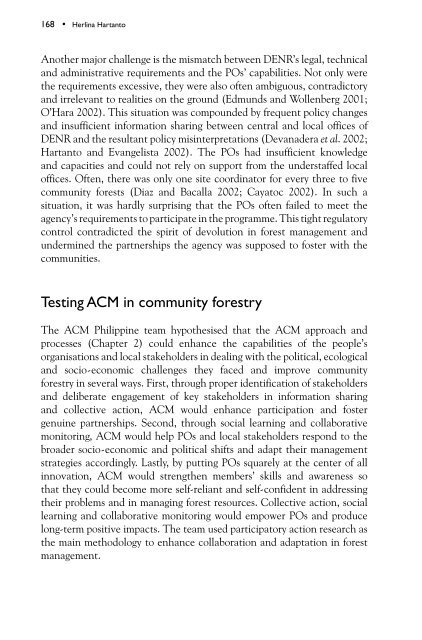Adaptive collaborative management of community forests in Asia ...
Adaptive collaborative management of community forests in Asia ...
Adaptive collaborative management of community forests in Asia ...
You also want an ePaper? Increase the reach of your titles
YUMPU automatically turns print PDFs into web optimized ePapers that Google loves.
168 • Herl<strong>in</strong>a Hartanto<br />
Another major challenge is the mismatch between DENR’s legal, technical<br />
and adm<strong>in</strong>istrative requirements and the POs’ capabilities. Not only were<br />
the requirements excessive, they were also <strong>of</strong>ten ambiguous, contradictory<br />
and irrelevant to realities on the ground (Edmunds and Wollenberg 2001;<br />
O’Hara 2002). This situation was compounded by frequent policy changes<br />
and <strong>in</strong>sufficient <strong>in</strong>formation shar<strong>in</strong>g between central and local <strong>of</strong>fices <strong>of</strong><br />
DENR and the resultant policy mis<strong>in</strong>terpretations (Devanadera et al. 2002;<br />
Hartanto and Evangelista 2002). The POs had <strong>in</strong>sufficient knowledge<br />
and capacities and could not rely on support from the understaffed local<br />
<strong>of</strong>fices. Often, there was only one site coord<strong>in</strong>ator for every three to five<br />
<strong>community</strong> <strong>forests</strong> (Diaz and Bacalla 2002; Cayatoc 2002). In such a<br />
situation, it was hardly surpris<strong>in</strong>g that the POs <strong>of</strong>ten failed to meet the<br />
agency’s requirements to participate <strong>in</strong> the programme. This tight regulatory<br />
control contradicted the spirit <strong>of</strong> devolution <strong>in</strong> forest <strong>management</strong> and<br />
underm<strong>in</strong>ed the partnerships the agency was supposed to foster with the<br />
communities.<br />
Test<strong>in</strong>g ACM <strong>in</strong> <strong>community</strong> forestry<br />
The ACM Philipp<strong>in</strong>e team hypothesised that the ACM approach and<br />
processes (Chapter 2) could enhance the capabilities <strong>of</strong> the people’s<br />
organisations and local stakeholders <strong>in</strong> deal<strong>in</strong>g with the political, ecological<br />
and socio-economic challenges they faced and improve <strong>community</strong><br />
forestry <strong>in</strong> several ways. First, through proper identification <strong>of</strong> stakeholders<br />
and deliberate engagement <strong>of</strong> key stakeholders <strong>in</strong> <strong>in</strong>formation shar<strong>in</strong>g<br />
and collective action, ACM would enhance participation and foster<br />
genu<strong>in</strong>e partnerships. Second, through social learn<strong>in</strong>g and <strong>collaborative</strong><br />
monitor<strong>in</strong>g, ACM would help POs and local stakeholders respond to the<br />
broader socio-economic and political shifts and adapt their <strong>management</strong><br />
strategies accord<strong>in</strong>gly. Lastly, by putt<strong>in</strong>g POs squarely at the center <strong>of</strong> all<br />
<strong>in</strong>novation, ACM would strengthen members’ skills and awareness so<br />
that they could become more self-reliant and self-confident <strong>in</strong> address<strong>in</strong>g<br />
their problems and <strong>in</strong> manag<strong>in</strong>g forest resources. Collective action, social<br />
learn<strong>in</strong>g and <strong>collaborative</strong> monitor<strong>in</strong>g would empower POs and produce<br />
long-term positive impacts. The team used participatory action research as<br />
the ma<strong>in</strong> methodology to enhance collaboration and adaptation <strong>in</strong> forest<br />
<strong>management</strong>.
















